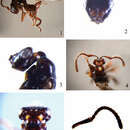Description
provided by Zookeys
Holotype Female. Body length 2.3 mm; fore wing length 2.5 mm. Body shiny, with sparse setae.
Head. Head in anterior view triangular, as wide as width of mesosoma at tegulae and 1.5 times the interocular distance; head in lateral view oblong (Fig. 3). Eyes situated on dorsal upper half of head (Fig.3). Clypeus with short and erect setae. Frontal projection (Figs 2–3) in frontal view bilobate and trapezoid, in lateral view weakly up curved and obliquely truncate, lower lateral corner with transverse carinae extending to two sides of clypeus, upper lateral corner with carinae extending backward along middle of inner margin of eye then to posterior ocelli. Frons sparsely and finely punctuate, with a reverse triangular depression area. Gena polished. Ocelli oval, with some micropunctures and short wrinkles around, MOD=2, POL=3, OL=1, OOL=8. Vertex (Figs 3, 5) abruptly sloping and angulate posteriad lateral ocelli. Cervical projection (Fig. 5) strongly constricted behind ocelli and eyes, and posteriorly expanded and shield-like dorsally, centrally with a shallow longitudinal furrow. Vertex, gena and anterior lateral sides of cervical projection with ribbon-like setae. Antenna stout (Fig. 4, 6), covered with long and dense setae, about equals to the length of body. Scape 5.0 timesas long as wide (Fig. 6), curved, without transparent flange. Pedicel similar to flagellar segments, 1.8 times as long as wide. Relative proportion of length to width of flagellomeres as follows: 40 : 32; 36 : 32; 36 : 32; 36 : 32; 36 : 32; 36 : 32; 36 : 34; 32 : 37; 31 : 39; 33 : 41; 67 : 40.
Mesosoma. Pronotum polished, with maximum width 1.4 times as long as maximum length, proximal basal width 0.8 times as long as ultimate apical width. Lateral margin ofpronotum rounded (Fig. 3), not sharp; anterior lateral sides of pronotum with short, narrow row of ribbon-like setae. Mesoscutum smooth, posterolateral projections lamellate, sparsely setose. Notauli complete, mesoscutum between notauli weakly concave. Parapsides indistinct. Tegula as long as pronotum, sparsely setose, and extending to posterior margin of scutellum. Scutellum smooth. Propodeal projection obtuse, inconspicuous.
Legs(Figs 7–9). Slender, with sparse bristles; all femora with small apical transparent flanges 1/8 times as long as femur; all tibiae without transparent flanges.
Wings. Fore wing (Fig. 10) infuscate, with hyaline streaks, covered with dense pubescence; venation highly reduced, restricted to basal 1/7; first anal vein distinct, parallel to and as long as M+Cu vein, cu-a vein indistinct, short. R1 vein 0.9 times, Rs vein 2.8 times and cu-a vein 0.3 times as long as length of stigmal vein. Hind wing veinless.
Metasoma(Fig. 1). First tergite subtriangular, maximum length 0.5 times the maximum width; second tergite weakly trapezoid, with maximum length 0.75 times maximum width; third tergite narrow, 0.5 times as long as wide; fourth tergite weakly exposed; all tergites smooth, scattered with sparse setae. Segments and ovipositor that retracted within metasoma as illustrated (Figs 11, 12).
Colour. Body dark red. Antennae and legs reddish brown.
- license
- cc-by-3.0
- copyright
- Jing-xian Liu, Jie-min Yao, Zai-fu Xu
- bibliographic citation
- Liu J, Yao J, Xu Z (2011) A new species of the rare chrysidid subfamily Loboscelidiinae from China: the third species of Rhadinoscelidia Kimsey, 1988 (Hymenoptera, Chrysididae) ZooKeys 87: 11–17
- author
- Jing-xian Liu
- author
- Jie-min Yao
- author
- Zai-fu Xu

